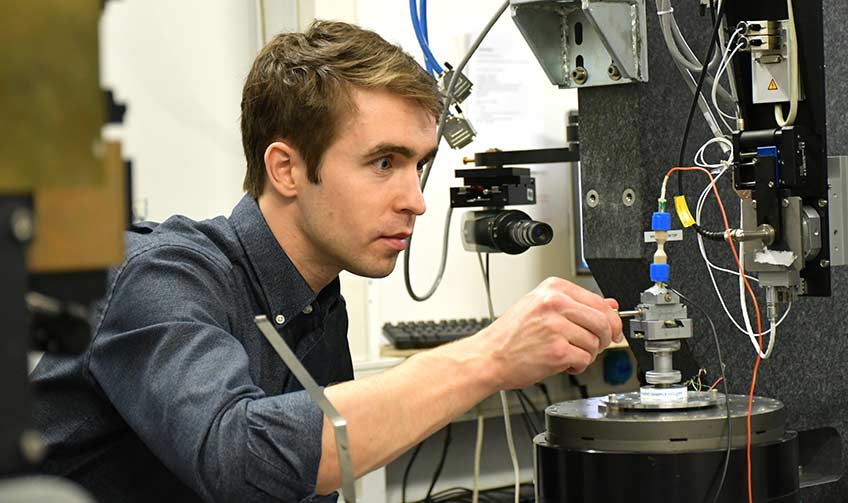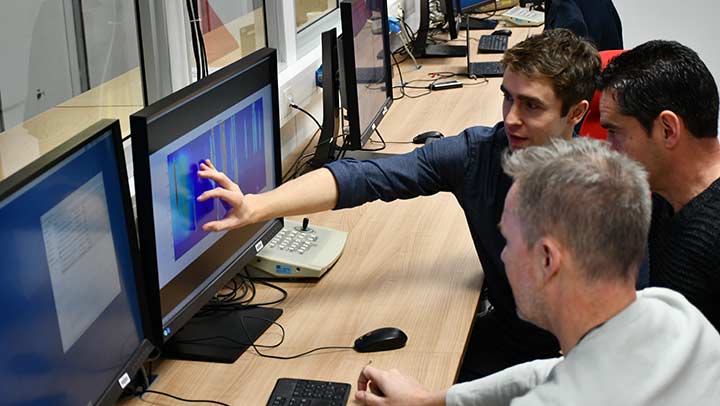Excellence in X-Ray Research Earns NREL Scientist Prestigious Award
The European Synchrotron Recognizes Donal Finegan with Its 2020 Young Scientist Award

Energy storage researcher Donal Finegan, a staff scientist at the National Renewable Energy Laboratory (NREL), recently received the 2020 Young Scientist Award for his groundbreaking work at the European Synchrotron Radiation Facility (ESRF). Finegan has collaborated closely with ESRF throughout his career, focusing on the degradation and failure mechanisms of lithium-ion (Li-ion) batteries. As part of this research, Finegan pioneered high-speed X-ray imaging for diagnosing battery failure with implications across the materials science spectrum.
Using the ESRF’s world-class capabilities, Finegan also helped develop the application of X-ray diffraction computed tomography for taking a close-up look at the chemical and structural changes in battery electrodes. His technique is unique in that, for the first time, Finegan imaged localized particles within the greater structure of a battery electrode. In a recent Nature Communications article, Finegan expanded on his findings, which showed the ways in which each particle reacts differently to the incorporation of lithium into the battery electrode. This research will improve understanding of how microscopic changes lead to battery failure over time so that researchers can identify strategies to improve the performance and safety of Li-ion batteries, which are vital components in cell phones, laptops, and electric vehicles.
This advancement is a maturation of Finegan’s ongoing battery degradation research at NREL and from his doctoral research at University College London, where he previously used high-energy synchrotron X-rays and thermal imaging to capture thermal runaway — otherwise known as the moment when a battery overheats and, in the worst of cases, potentially ignites. Such catastrophic failures can occur in the blink of an eye, and the interesting dynamics of thermal runaway are usually hidden behind steel casings requiring very high-speed X-ray imaging to see. At the ESRF, his team achieved an astounding imaging rate of 20,000 frames per second of a battery undergoing thermal runaway, diagnosing how and why they fail so violently. Finegan has also worked closely with the NASA Johnson Space Center to use insights achieved during these experiments to clarify the risks of Li-ion batteries and help guide battery selection and safe system design for human space-flight applications.

ESRF selects Young Scientist Award recipients based on outstanding work conducted at the facility. As the world’s most advanced synchrotron, ESRF hosts more than 9,000 scientists a year studying the inner structure of materials and living matter down to the atomic level. The new X-ray imaging technique that Finegan helped develop has a vast range of uses — from cutting-edge medical advances of the future to archeology discoveries from the past.
“We selected Donal for this award due to his innovative, high-quality research on a topic of great current academic and public interest, namely lithium-ion battery failure and degradation," said ESRF Chairman Michela Brunelli.
This award is far from Finegan’s first. Since joining NREL in 2017, he has received a Global Young Researcher Award from the Institution of Chemical Engineers, as well as a Collaborate to Innovate Award from The Engineer magazine. Prior to joining NREL, Finegan completed his Ph.D. in chemical engineering at University College London and worked at the U.K. National Physical Laboratory.
Learn more about how NREL's energy storage innovations are accelerating the development of high-performance, cost-effective, and safe energy storage systems.
Learn more about NREL’s transportation research.
Last Updated May 28, 2025
